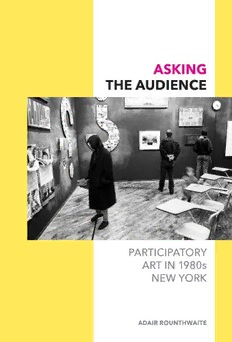
Asking the audience: participatory art in 1980s New York PDF
Preview Asking the audience: participatory art in 1980s New York
ASKING THE AUDIENCE This page intentionally left blank ASKING THE AUDIENCE PARTICIPATORY ART IN 1980s NEW YORK ADAIR ROUNTHWAITE University of Minnesota Press Minneapolis | London The University of Minnesota Press gratefully acknowledges financial assistance for the publication of this book provided by the University of Washington College of Arts and Sciences and the Wyckoff Milliman Endowment for Faculty Excellence from the School of Art + Art History + Design. Portions of chapter 3 were previously published in “In, Around, and Afterthoughts (On Participation): Photography and Agency in Martha Rosler’s Collaboration with Homeward Bound,” Art Journal 73, no. 4 (Winter 2014): 46– 63. Copyright 2017 by the Regents of the University of Minnesota All rights reserved. No part of this publication may be reproduced, stored in a retrieval system, or transmitted, in any form or by any means, electronic, mechanical, photocopying, recording, or otherwise, without the prior written permission of the publisher. Published by the University of Minnesota Press 111 Third Avenue South, Suite 290 Minneapolis, MN 55401- 2520 http://www.upress.umn.edu Printed in the United States of America on acid- free paper The University of Minnesota is an equal- opportunity educator and employer. 23 22 21 20 19 18 17 10 9 8 7 6 5 4 3 2 1 Library of Congress Cataloging-in-Publication Data Names: Rounthwaite, Adair, 1983– author. Title: Asking the audience : participatory art in 1980s New York / Adair Rounthwaite. Description: Minneapolis : University of Minnesota Press, 2017. | Includes bibliographical references and index. Identifiers: LCCN 2016046648 (print) | ISBN 978-0-8166-9872-1 (hc) | ISBN 978-0-8166-9873-8 (pb) Subjects: LCSH: Interactive art—New York (State)—New York. | Art, American—New York (State)—New York—20th century. Classification: LCC N6535.N5 R66 2017 (print) | DDC 702.81—dc23 LC record available at https://lccn.loc.gov/2016046648 For Erik This page intentionally left blank CONTENTS 1 Introduction: Recovering Audience 31 1. The Politics of Participation 75 2. The Pedagogical Subject of Participation 113 3. Photography, Agency, and Participation 155 4. Art, Affect, Crisis 203 Conclusion: Participation in the Present 211 Acknowledgments 215 Notes 251 Index FIGURE I.1. A ready- made sign declaring “Under New Management” hung briefly outside the Dia Art Foundation’s gallery at 77 Wooster Street, New York City, during Group Material’s Democracy, “Cultural Participation” installation, November 19– December 10, 1988. Courtesy of Group Material and Four Corners Books. INTRODUCTION RECOVERING AUDIENCE It seems appropriate to begin a discussion of “audience” by taking note of the fact that there is anything to discuss. Martha Rosler, “Lookers, Buyers, Dealers, and Makers: Thoughts on Audience,” 1979 In November 1988, members of the artists’ collective Group Material hung a sign declar- ing “Under New Management” above the street entrance to the Dia Art Foundation’s gallery at 77 Wooster Street in Soho. The cloth sign (Figure I.1), with three white words in different fonts on a black background, was a found object, the kind of ready- made announcement used to publicize a change in store management. Shortly after the sign was hung, conversations between Group Material members and Dia staff ensued. Curator Gary Garrels informed the artists that Dia staff were disturbed by the sign and by what it might imply about Dia. Group Material member Julie Ault recalls that after discussion, the group decided to remove it, in part because it seemed it might be functioning in a more heavy- handed way than they had originally intended.1 Group member Doug Ashford remembers this as the only time during Democracy, a project that lasted for five months and that was in preparation for over a year before that, when Dia, an organization that placed a high value on the wishes of artists, refused a request made by Group Material.2 Clearly, the sign had struck a nerve. Group Material’s Democracy ran from September 1988 to January 1989 and was followed by Martha Rosler’s If You Lived Here . . . from January to April 1989, running to the end of Dia’s programming year.3 Like Democracy, If You Lived Here . . . consisted of a series of changing exhibitions on social and political topics. Group Material’s project comprised the segments “Education and Democracy,” “Politics and Election” (Plate 1) (co- inciding with the lead- up to the presidential election), “Cultural Participation,” and “AIDS
